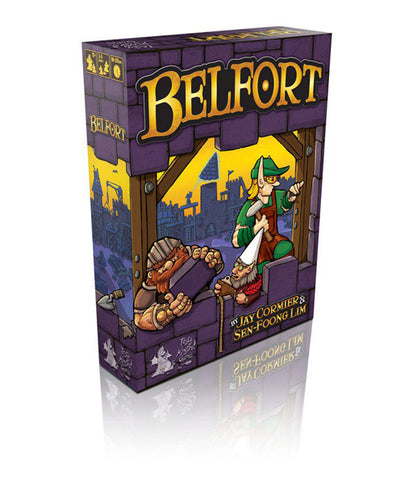 |
| (c) Tasty Minstrel Games Used by permission |
We've played twice now, although we've never quite got through an entire game start to finish. And sad to say, we're not inclined to get it to the table again any time soon. We both found ourselves going through the motions of the game, deciding where to put our dwarves and elves, building buildings and trying to gain majority control of city sectors - but the game seemed to lack that sense of purpose and strong forward direction that a solid game like Agricola gives us. It might be that we need to play the game all the way to the end to understand the full import of what is happening in the first three rounds, but honestly, we looked at the calendar / turn record chart after the first scoring round and asked, "do we really have to keep doing this?"
Don't get me wrong. I really want to like Belfort. I feel as though I'm supposed to like it. The first printing sold out like crazy, and it's in a second printing only a year after the initial release. It's in the top 250 games on BoardGameGeek. Okay. So why doesn't it light a fire under me the way Puerto Rico does? I look at the buildings, and each one gives me some special thing it does, but I don't see a whole lot of chain reaction going on among my actions, no real "engine" that sparks a sequence of abilities that crank out victory points. Just, well, trying to outnumber my opponent in city sectors, dwarves, elves, and gnomes. Okay.
Even some of the decision trades seem inconsequential. Often I find that I have different ways to accomplish the same thing, and they are all functionally equivalent based on the wood-stone-metal-gold exchange rate. I feel as though I have to win the game by edging out individual marginal bonuses. I understand that optimization is part of a lot of games, but in this case it just feels like squeezing out a point here and there. In short, Belfort has left us flat in the first couple of plays, and we're going to have it on the back burner for a little while as we explore other candidates in our game cabinet.
 |
| (c) Lookout Games Used by permission |
In some ways, Le Havre is Agricola turned inside out. Players have exactly one action token; there's no family to grow, there's no house to expand and renovate. There is, however, a company to feed, and it gets hungrier every round, so food is a concern. Another fascinating mechanic is the way that available resources accumulate from one turn to the next. Rather than boost every available resource every round, only two resources incrementally increase the amount to take each turn. Some (like wood) get boosted more often than others (like iron), but nothing gets fully replenished right away. It's almost as though every round is sliced into seven sub-rounds. If you aggregate all the resource accumulation that occurs in a full round, then you could say that it looks like one full round of Agricola. That's especially true since each player has only one main action in each turn, rather than two, or three, or five.
The real engine-growth aspect of Le Havre emerges in the chains of events that are necessary to generate refined products. Some are straightforward, like taking fish to the smokehouse and burning one wood to convert six fish to six smoked fish (which have twice the food value). Some chains are more elaborate, such as obtaining hard-to-get iron and coal, converting coal to coke, using the coke to convert the iron to steel, then spending more energy to build a steel ship (or to ship the steel for money). Steel is the most profitable finished product and useful in many ways, but it takes a lot of actions and energy to bring it home. That's a lot of opportunity cost, and that's where the strategy is most interesting for Le Havre.
Tonight I won for the first time in three games, mostly by aggressive building. Kathy focused on getting the steel shipment process going and made more money selling than I did. I was breeding cattle and slaughtering them for meat and hides, but I never got the hides to the tannery to convert them to leather to ship for money.
We're gradually getting faster at this game. I think once we really get it going, we'll switch from playing the shortened version to playing the full game. For now, a mere eight rounds seems challenging enough. Le Havre has become our favorite worker placement, and I think the primary reason is that it has a strong sense of progress and strategic direction that make for a rewarding experience.
I should probably try Agricola, and the LeHavre games someday.
ReplyDeleteLeHavre uses the same design concept I hit on about 20 years ago for the 35-years-in-the-making Nations game, which is one commodity goes to the refinery and turns into another, e.g. ore turns into metal, timber turns into wood.
Strive to design a game where -- instead of some market planner deciding where each worker goes like in some state-controlled communist land -- each worker decides for himself where to work, in response to the market forces of supply and demand (good luck rolling education in there), to reflect Adam Smith's invisible hand.
I think in that respect you'd be frustrated by worker-placement games like Agricola and Le Havre. To some extent, the tactics turn on the limitation that if I take an action, you can't take that same action until I leave that space.
ReplyDelete